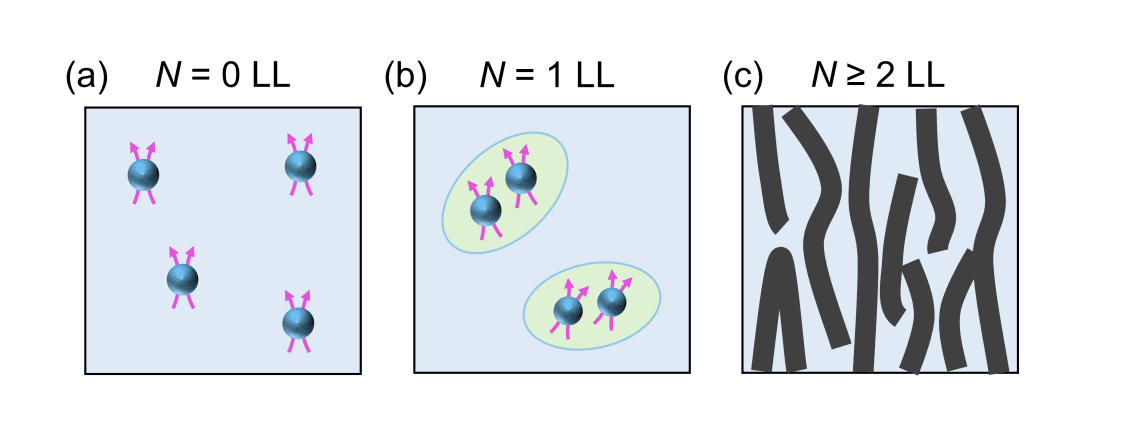The fractional quantum Hall effect, a state of matter exhibiting exotic properties, continues to surprise physicists with new manifestations of topological order, and recent work reveals a fascinating link to spontaneous symmetry breaking. Chengyu Wang from Princeton University, alongside A. Gupta and S. K. Singh, and colleagues, now report the observation of fractional quantum Hall states exhibiting highly anisotropic behaviour, even when measured in a perfectly perpendicular magnetic field. This achievement, made possible through ultrahigh-quality samples of a two-dimensional hole system, demonstrates the emergence of nematic quantum Hall states at specific fractional fillings, notably 5/2 and 7/2. The team’s findings not only reveal a new state of matter where fundamental symmetries break down spontaneously, but also suggest the potential for hosting quasiparticles with unusual exchange statistics, opening exciting avenues for exploring fault-tolerant quantum computation.
Anisotropic fractional quantum Hall states (FQHSs) represent an intriguing connection between emerging topological order and spontaneous symmetry breaking. While FQHSs have previously been reported in GaAs quantum wells, these observations required tilted magnetic fields which explicitly break rotational symmetry. This work reports the observation of FQHSs exhibiting highly anisotropic longitudinal resistances in purely perpendicular magnetic fields, specifically at even-denominator Landau level fillings of 5/2 and 7/2 in ultrahigh-quality GaAs two-dimensional hole systems. The coexistence of FQHSs and spontaneous symmetry breaking at these half fillings signals the emergence of nematic FQHSs, which likely harbour non-Abelian quasiparticles.
Anisotropic Fractional Quantum Hall States Explained
The research centers on understanding how energy levels, known as Landau levels, become blurred due to interactions and disorder, a phenomenon called Landau level mixing. This mixing is essential for the formation of anisotropic phases. Scientists also explored how electron wavefunctions, described by mathematical entities called spinors, contribute to anisotropy, with the composition of these spinors, specifically the presence of higher-energy components, appearing crucial for hosting anisotropic phases. Calculations of energy levels and spinor compositions as a function of magnetic field and electron density reveal key insights into the system’s behavior.
Calculations show that certain Landau levels, notably the alpha and gamma levels, exhibit different characteristics. The alpha level possesses a significant higher-energy component, while the beta level lacks it, making it less likely to host anisotropic phases. The gamma level, like the alpha level, contains significant higher-energy components and is therefore likely to support anisotropic phases. These findings suggest that specific Landau levels play a critical role in the emergence of anisotropic states, and researchers believe that Landau level mixing and spinor composition are key ingredients in forming these anisotropic states, using the composition of spinors as a way to understand and predict the system’s properties.
Anisotropic Fractional Quantum Hall States Observed
This research demonstrates the observation of anisotropic fractional quantum Hall states (FQHSs) in ultrahigh-quality GaAs two-dimensional hole systems, achieved without applying external symmetry-breaking fields. Scientists observed highly anisotropic longitudinal resistances at even-denominator Landau level fillings of 5/2 and 7/2, demonstrating the emergence of nematic FQHSs, which are predicted to harbor exotic quasiparticle excitations. Measurements reveal that at a filling factor of 7/2, the longitudinal resistance approaches zero while the perpendicular resistance reaches approximately 2 kΩ, a significant anisotropy, with the Hall resistance approaching 2h/7e2 to within 2%, indicating a developing anisotropic FQHS. Further experiments at ν = 5/2 reveal a sharp minimum in perpendicular resistance accompanied by a developing Hall plateau, also demonstrating anisotropic transport.
Similar anisotropic features were observed at odd-denominator fillings, suggesting a common mechanism driving the anisotropy across multiple fractional quantum Hall states. Temperature-dependent measurements demonstrate that the anisotropic transport persists to higher temperatures, even after the FQHS features diminish, similar to observations in tilted magnetic fields. The team also investigated the temperature dependence of these states, finding that at certain fillings, transport remains isotropic, while at others, resistance components diverge and exhibit opposite trends at low temperatures, signaling the emergence of nematic order.
Nematic Quantum Hall States Observed in Holes
This research demonstrates the observation of nematic fractional quantum Hall states (FQHSs) in ultrahigh-quality gallium arsenide two-dimensional hole systems, revealing spontaneous rotational symmetry breaking at specific electron densities. Scientists observed these anisotropic states at both even and odd-denominator filling fractions, specifically at 5/2 and 7/2, and documented transitions between isotropic and anisotropic phases by tuning the electron density. The significance of this work lies in establishing a new platform for exploring strongly correlated electron systems and potentially engineering novel interaction phenomena, with the multi-orbital nature of the electrons in gallium arsenide, arising from the mixing of heavy-hole, light-hole, and spin-orbit couplings, appearing crucial in supporting the coexistence of topological and nematic orders. Researchers acknowledge that computational challenges currently limit detailed analysis of similar anisotropic states observed in tilted magnetic fields. Future research may benefit from advancements in atomically-thin two-dimensional materials, such as graphene and transition metal dichalcogenides, which offer alternative platforms for studying FQHSs and many-body physics. However, modulation-doped gallium arsenide quantum wells remain a leading material system due to their high electron mobility and relatively large sample size, offering advantages for both fundamental discovery and potential applications, highlighting the critical importance of sample quality in revealing emergent phenomena in quantum materials.
👉 More information
🗞 Even-denominator fractional quantum Hall states with spontaneously broken rotational symmetry
🧠 ArXiv: https://arxiv.org/abs/2510.01482

